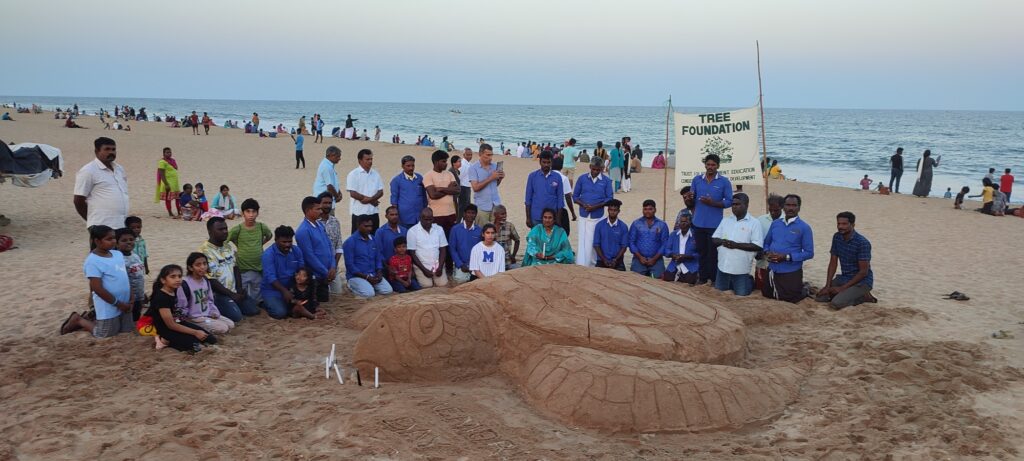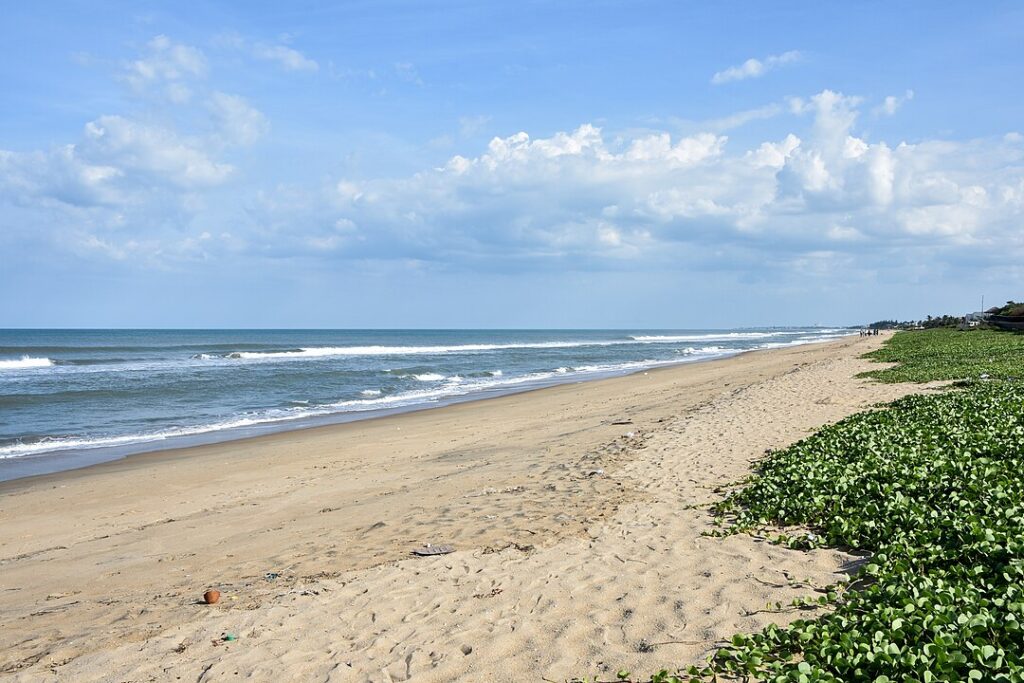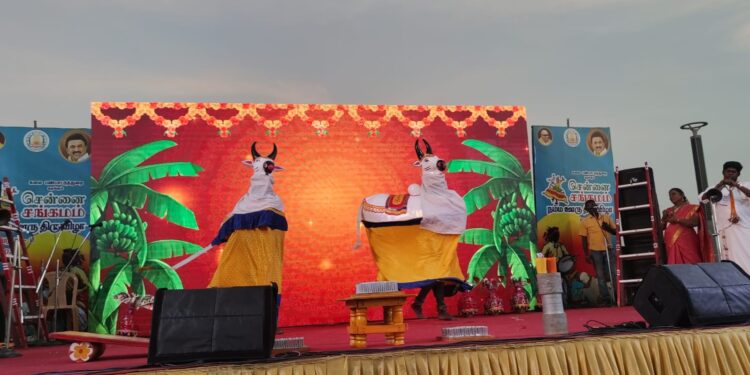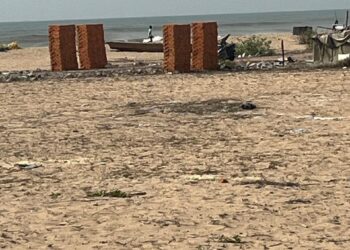By R.Swathi
As the city celebrates the many festivals across the city, it often forgets to respect the very living beings and nature that the festivals celebrate. During Pongal, the Chennai Sangamam was celebrated throughout Chennai and one of the locations was Elliot’s beach. The celebrations were on for 4 days – Jan 14 to 17, from 6 pm to 9 pm.
The months of January and February are also the turtle nestling season. The Chennai coast is an active breeding ground for the endangered Olive Ridley Turtles, and Elliot’s Beach is one of them. Such loud activity is known to hamper the nestling season.
The Students Sea Turtle Conservation Network (SSTCN) is a voluntary group, mainly comprising students and young adults who have been working in the beaches of Chennai since 1987, trying to conserve and create awareness about the endangered Olive Ridley sea turtle.
SSTCN explains how the loud and bright light affects the turtles: Young baby turtles when they emerge from their nests on the beach are programmed to move towards a brighter horizon. Moonlight and starlight reflected off the sea is what guides them in the right direction. With the powerful lights of the festivities, the hatchlings get disoriented and end up moving landward rather than seaward. The babies have enough stored food in them to last only 24 hours and they need to reach their food base (the ocean) within that time. When they move towards land, they lose all their energy and get dehydrated when the sun comes up, or are eaten by other animals, or even get run over by vehicles when there are roads next to beaches.
Activists are already concerned with the high mast lamp at the Elliot’s and Thiruvanmiyur beaches that remain lit for most part of the night. The activities at the beach till beyond sunset adds to the disorientation for the turtles.
“On one hand the government announces a Coastal Restoration Mission, sea turtle rehab centre & conservation and stopping of marine pollution, and on the other hand facilitates mindless noise, light and land pollution! Such illuminated and noisy events have adverse impacts if conducted on the beach. After dusk, the beach should have minimal lighting sufficient for the safety of beachgoers. Even the current bright lamps of the shops towards the shore and the so-called amusement park need to be stopped,” says Dr.T.D.Babu, Co-Founder of civic body Spark and a marine biologist, while pointing out that the celebrations are ill-timed at Elliot’s beach, “Trutles are worst affected during this period whereas other marine/coastal living communities are affected throughout the year due to light and noise pollution besides land pollution.” He adds that Elliot’s beach is already strained with the umpteen activities carried on there, resulting in the degradation of its ecology – rampant littering, uprooting of the Goat Feet creeper and destroyed sand dunes.
Know more about Olive Ridley Turtles
The olive ridley gets its name from the olive green colour of its heart-shaped shell. The species is among the smallest of the world’s sea turtles and is found primarily in the tropical regions of the Pacific, Indian, and Atlantic oceans. In India, they nest on the east coast. The nesting season is from Jan to March in Tamilnadu. Turtle walks are conducted during this season from the Neelankarai beach to Elliot’s beach wherein the eggs are collected and safeguarded at hatcheries and released later in May.

Olive ridley turtles are found throughout the world. The number of olive ridleys has greatly reduced from historical estimates (for example, 10 million olive ridleys in the Pacific Ocean), due to overexploitation for turtle meat and eggs. Bycatch in fishing gear and the direct harvest of turtles and eggs are the biggest threats facing Olive Ridleys.
Organisations working towards their conservation in Chennai are Students Sea Turtle Conservation Network (sstcn.org) and Tree Foundation (treefoundationindia.org).
Know more about Goat’s Feet creeper

The Goat’s Feet (Ipomoea pes-caprae; Attukaal in Tamil) is an evergreen creeper and is a primary sand stabilizer, being one of the first plants to colonise dunes. It grows on sand dunes and beaches above the high tide line in tropical and subtropical regions of the world. It is a useful sand binder, thriving under conditions of sandblast and salt spray. Its leaves are used to relieve stings and bites from insects, stingrays and snakes as well as a cure for skin irritations, boils, skin infections, ringworm and haemorrhoids.
How do beach sand dunes protect us?
The ocean and the wind can have an unpredictable, destructive force on coastal regions, and sand dunes protect inland areas from swells, tides, and winds apart from preventing or minimising coastal flooding and structural damage. They must thus be protected.
A research paper at Horizon – The EU Research and Innovation magazine, explains, “‘Dunes are keepers of sand, they are reservoirs,’ said Freitas. ‘When there are bigger and stronger waves during storms, the sand is taken from the beach, which creates an underwater barrier, so the next waves will be blocked.’ Eventually, over weeks or months, more gentle waves gradually return the eroded sand from offshore to the beach. This fluctuating of the shoreline backwards and forwards over time is a normal coastal process that is hardly noticeable in normal times but can be dramatic during storms.” (https://projects.research-and-innovation.ec.europa.eu/en/horizon-magazine/sand-dunes-offer-clues-coastal-erosion-and-how-prevent-it.)
While countries like the Netherlands, USA and Australia are launching projects to protect the sand dunes on the beaches, in India, in a first, a panchayat at Goa (Varca local panchayat) has taken the initiative to restore a sand dune after it was destroyed due to illegal actions. Tourism and related activities are said to have corroded at least 27% of Goa’s beaches. (https://www.gomantaktimes.com/opinion/the-destruction-of-goas-sand-dunes.)










